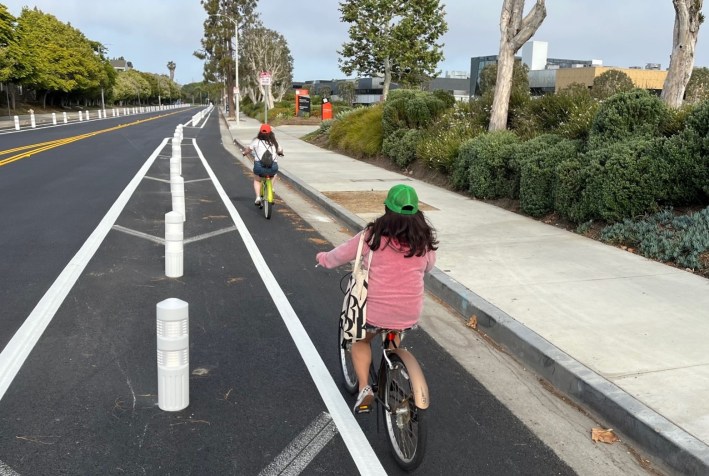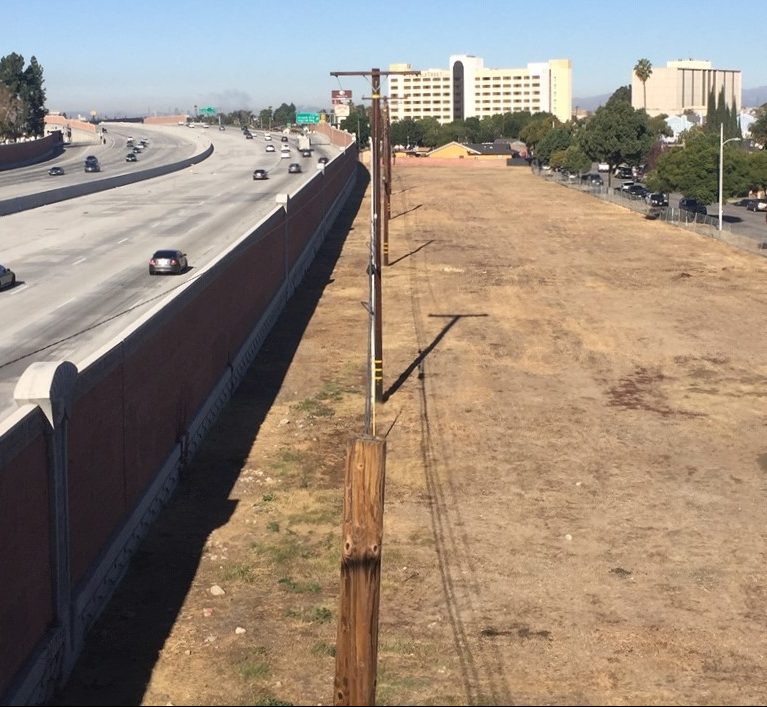It's the post you probably haven't been waiting for: Streetsblog L.A.'s annual look back at the past year of L.A. City bikeway implementation - the good, the bad, and all the meh in between. In Fiscal Year 2023-24, the city installed an underwhelming 22.5 lane-miles of new or improved bike facilities. This was down from 45 miles last fiscal year, and is the lowest annual mileage since FY2018-19.

While there is some year-to-year variation, and some lag time between project planning getting underway and on the ground upgrades, the first full fiscal year does not look like a promising start for Mayor Karen Bass. Bass has prioritized critical housing issues and not paid much attention to safer multimodal streets - at least not yet. FY2024 did see Mayor Karen Bass appoint Laura Rubio-Cornejo to head the city Transportation Department (LADOT). Rubio-Cornejo replaced interim GM Connie Llanos last September.
Bikeway mileage data is from LADOT's calendar year 2023 Annual Report and a subsequent LADOT FY2324 bikeways list, reconciled in SBLA's annual spreadsheet.
FY23-24's 22.5 mile total includes 12.5 miles of new bikeways, plus 10.2 miles of upgrades minus 0.2 miles of downgrades.
As some bike facilities are safer than others, SBLA annual coverage attempts to tally higher quality facilities. Not counting bike routes (generally near-worthless sharrows), the yearly output was 11.6 new bike lane/path lane-miles. Significant quality upgrades (existing unprotected facilities converted to protected) totaled 6.5 lane-miles. These totals were both down from the prior year, which saw 21.8 new lane/path lane-miles and 12.6 miles of significant upgrades.
Below are some factors that influenced this year's output:
- Street Resurfacing - LADOT continues to add most new bikeways and most upgrades during Bureau of Street Services (StreetsLA) road resurfacing. This is the least expensive time to reconfigure lanes; the street "goes black" and city needs to re-stripe it. City resurfacing and adding bikeways have been somewhat connected for decades. For the past half-dozen years, the connection was strengthened by city policies (responding to cyclist death/injury lawsuits) and interdepartmental collaboration - formal and informal. More on resurfacing is in the Measure HLA section below (and in past SBLA coverage).
- Council Leadership - The City Council plays a huge role - for better and for worse - in what bikeways get built where. The paucity of this year's mileage points to a council that (even with recent turnover displacing some openly anti-bike councilmembers) did not make bikeways a high priority during the past fiscal year. This year's one honorable mention goes to Councilmember Bob Blumenfield, who was the elected official primarily responsible for outstanding extensive multimodal upgrades on Reseda Boulevard completed this year. Reseda and Variel Avenue are among many worthwhile bike projects Blumenfield has shepherded in a fairly car-centric suburban district (though Ventura Boulevard underwhelmed). [Councilmember mileage totals are at bottom of SBLA spreadsheet.]
- Discouraging Parking Under Freeways - Apparently in response to the pallet fire that damaged the 110 Freeway, the city took steps to prevent vehicles from stopping/parking under freeways. Under the 105 Freeway, LADOT retooled three streets - Broadway, Hoover Street, San Pedro Street - by adding new plastic-bollard protection to existing bike lanes.
And then there's the elephant in the room: Measure HLA.
FY2024 saw the passage of Measure HLA which now mandates that the city install planned bike/walk/bus facilities during street work, mainly resurfacing. Voters approved HLA in March; it became law on April 9.
Due to some combination of unreadiness and resistance, StreetsLA effectively put HLA upgrades on hold from April 9 through mid-September. From July 2023 through April 9, the city was installing an average of just over two miles of bike projects per month; after April 9 this dropped to less than a third of a mile per month. For FY24 repaving done after April 9, it appears that the city installed only one bike project (on Cabrini Drive, a non-HLA street). Hollywood Boulevard, Manchester Boulevard, and a couple other recent bikeways were completed after June 30, so they will count toward FY24-25.
Hopefully in future years bikeway mileage will increase due to Measure HLA.
The Good

The city completed an excellent series of upgrades along the most bicycled stretches of Reseda Boulevard. After years of construction, the city opened the Reseda Boulevard Complete Streets Project. The project included closing bike lane gaps, upgrading unprotected bike lanes to parking-protected, and adding bus stop, walk, and rainwater upgrades.
Reseda Boulevard now holds L.A. City and County records for longest continuous protected bike lanes (3.9 miles), longest continuous on-street bike facility (9.9 miles), and the most total bike lane miles (11.7 miles).

Though it is still under construction, LADOT is counting several blocks of Downtown L.A.'s 7th Street Streetscape project in FY24 mileage. These concrete-curb-protected bike lane blocks are open to cycling, though additional features (including trees and lighting) are still pending. This project will be among the best bikeways in Southern California; the only real complaint is that it is taking so long. Construction got underway in early 2022, and looks likely to continue into mid-2025.

Pleasant new parking-protected bike lanes on Woodland Hills' Variel Avenue make a worthwhile connection to the G Line bike/walk path.

LADOT added new a half mile of new plastic-bollard-protected bike lanes on Gage Avenue between Central Avenue and Avalon Boulevard in South L.A.

LADOT added just over a half mile of new protected bike lanes on Glencoe Avenue in the community of Del Rey.

LADOT installed 1.25 miles of bike lanes on Lincoln Park Avenue, Flora Avenue and Sierra Street in northeast L.A., including reducing the number of car lanes (a road diet) for nearly a mile.

During resurfacing, LADOT continued to extend and improve bike lanes on Foothill Boulevard in Lake View Terrace.

New bike lanes on Water Street opened alongside the Wilmington Waterfront Promenade.

As mentioned above, the city added new plastic bollard protection upgrading three stretches of existing bike lanes below the 105 Freeway: on Hoover Street, San Pedro Street, and northbound Broadway.

During resurfacing, LADOT improved a short stretch of Laurel Canyon Boulevard in North Hollywood.

Another LADOT road diet project, during resurfacing, the city closed a one-block bikeway gap on Platt Avenue in West Hills (also adding new buffers to existing bike lanes).
The Meh
None of these "meh" bikeways are bad; they're positive, but too flawed or too modest to really celebrate. Cyclists will ride on all of these, but on the whole they're meh.

After StreetsLA resurfacing, LADOT added new mostly buffered bike lanes on Cabrini Drive, a somewhat steep residential street off of Glenoaks Boulevard, just north of the city of Burbank.

The city continued to extend Mason Avenue bike lanes in the hilly suburban Porter Ranch area as long planned.

Metro installed one block of Alameda Esplanade bikeway in Little Tokyo, completing it in early 2024.
It's a great facility: curb-level, two-way, and tree-lined with rain gardens. It would have been even better if Metro had built the full project instead of cutting the esplanade length from 1,500 feet to 500 feet.
For the truncated project, Metro narrowed the esplanade width from 35 feet to 30-33 feet, widening the adjacent roadways, and squeezing in a new turn lane that allows drivers to hook right on either end of the bikeway. Metro, with city sign-off, also installed more permissive angles at curbs, making biking beyond the one block esplanade more dangerous.
The wholesale downgrades of the esplanade effectively jettison Metro planning efforts for Alameda walk/bike connections to Union Station.
But that one block is nice.

StreetsLA's Parthenia Street and Sepulveda Boulevard Streetscape and Safety Improvement Project includes some good features: a stretch of parking-protected two-way protected bikeway and a big new traffic circle.
Sadly these are undermined by its flawed design: a hodgepodge of two-way and one-way segments which anticipate cyclists will make four turns to continue straight through an intersection. People there, on foot and on bike, ignore the city's puzzling directions, and instead cut across the roadway, or ride on the sidewalks.

The Reimagine Ventura Boulevard project (in Woodland Hills) was touted as a bike/pedestrian safety upgrade, but is an add-more-parking project at its core. Last summer the city installed the project's new back-in diagonal parking, plus a few crumbs for the cyclists: about a third of a mile of new unprotected bike lanes, and new intermittent buffers and green pavement markings added to existing unprotected bike lanes.

The city added sharrows on four blocks of Century Boulevard in Watts. The facility is one of eight streets segments planned for modest bike improvements as part of the city's Watts Rising grant (see page 69 for bikeways).
Transportation-wise, the grant has delivered new signalized pedestrian crossings, but very little in the way of planned streetscape and bike upgrades. Many of the bikeway streets appear to be awaiting resurfacing before the city can install bike features (some of the resurfacing was announced as part of the FY22-23 BLAST initiative, but never took place). On Century (which, due to HLA, would receive actual bike lanes if resurfaced today), the city installed sharrows on a cracked and potholed street surface, contrary to current city policy.

During resurfacing, LADOT added new buffers to existing bike lanes on Oxnard Street in Woodland Hills.
The Bad
LADOT adds bikeways and sometimes takes them away. This year the removals (that Streetsblog is aware of) include streets where the city took out bikeway buffers.

Late last year, LADOT removed a bike lane buffer (also removing green lane markings) on Santa Fe Avenue in the downtown Arts District.

LADOT also removed a short stretch of buffer along the Winnetka Avenue bike lanes, near the entrance to Pierce College.
Find previous annual bikeway mileage coverage from 2023, 2022, 2021, 2020 and 2019.





